The Nexus 7 (2013) Review
by Anand Lal Shimpi on August 22, 2013 6:00 PM ESTCPU Performance
The while the original Nexus 7 was fast for the money, the new Nexus 7 is just fast. Moving away from NVIDIA to Qualcomm, ASUS and Google settled on the APQ8064 Pro. Although we originally assumed this would be a quad-core Krait 200 based SoC, Brian's teardown revealed the part number 8064-1AA. What's special about that part number is it implies newer Krait 300 cores, making the SoC effectively a Snapdragon 600.
The CPU cores can run at up to 1.5GHz, putting it a bit lower than what we've seen from Snapdragon 600 based phones (e.g. HTC One tops out at 1.7GHz, while the US SGS4 hits 1.9GHz).
I was curious as to the impact of the lower frequency when combined with the potentially higher chassis TDP so I compared the Nexus 7 to the US Galaxy S 4. I turned to Geekbench because it offers a nicely woven mixture of single and multithreaded benchmarks, letting me look at peak available single core performance as well as what happens when multiple cores are active and working.
In this first graph we're looking at the first Krait 300 core running the workload. I've zoomed in to a small portion of the benchmark so we can get a better idea of CPU behavior:
The Nexus 7's CPU0 is almost always pegged at 1.5GHz whereas we see a lot of bursty thermal management on the smaller SGS4. This isn't unexpected, but what ends up happening is the sustained performance advantage drops from a peak theoretical max of 26% down to a more reasonable average gain of ~8%.
I was curious to see if multithreaded workloads showed any different behavior. Here we're looking at the fourth CPU core (CPU3). Note that it's not always active, which is why you see parts of the graph drop down to 0KHz. Once again we see similarly static behavior from the Nexus 7. Even with all four cores active, when you need the performance the Nexus 7 delivers a full 1.5GHz. These tests are short enough where we don't see tremendous swings in frequency, but once again we do see some frequency modulation in a smaller chassis.
The end result is that the Nexus 7's 1.5GHz Krait 300 cores are slower than what you'd get in a Galaxy S 4, however the gap isn't nearly as large as you'd expect it to be thanks to the larger chassis and how the platform is tuned. The Nexus 7 can run at 1.5GHz more consistently than Snapdragon 600 based phones can run at 1.7/1.9GHz.
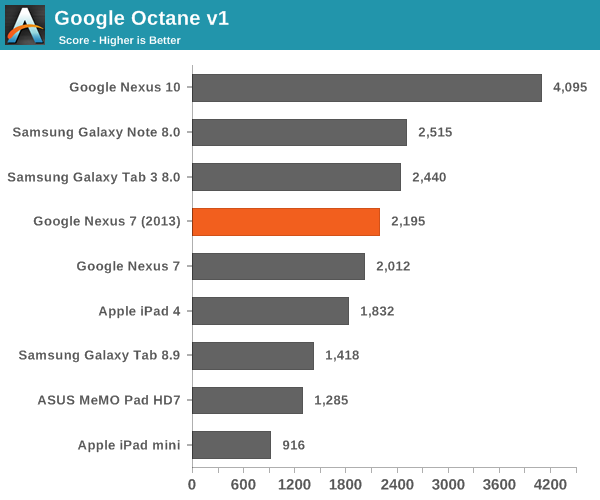


The GPU
Qualcomm seems to be frequency binning here, which is standard industry practice. Using binning to create these different SKUs gives Qualcomm pricing flexibility and also gives it the option to give large customers special treatment.
On the graphics side Qualcomm's Adreno 320 GPU makes an appearance. Clock speeds are also limited to 400MHz, compared to 450MHz for the high-end Snapdragon 600 implementations we've seen.
The APQ8064-1AA's dual-channel memory controller is populated with four x 16-bit DDR3L-1600 memory devices, giving the Nexus 7 a healthy amount of memory bandwidth. Peak memory bandwidth available to the APQ8064-1AA is 12.8GB/s, equalling what's available to Apple's A5X in the 3rd generation iPad with Retina display. Tons of memory bandwidth is obviously a pre-requisite for driving a high resolution display, and the combination of DDR3L-1600 and the Adreno 320 GPU delivers a butter smooth UI in all well written Android apps.
Although CPU performance is somewhat middle of the road compared to the rest of the landscape, GPU performance is faster than any other Nexus device on the market - and pretty much faster than any other similarly sized tablet:
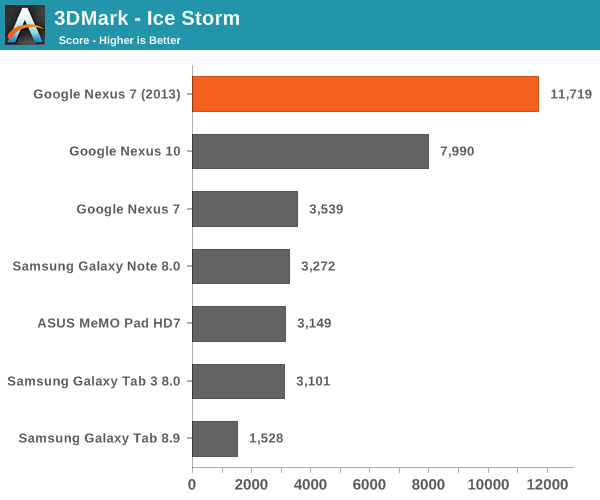
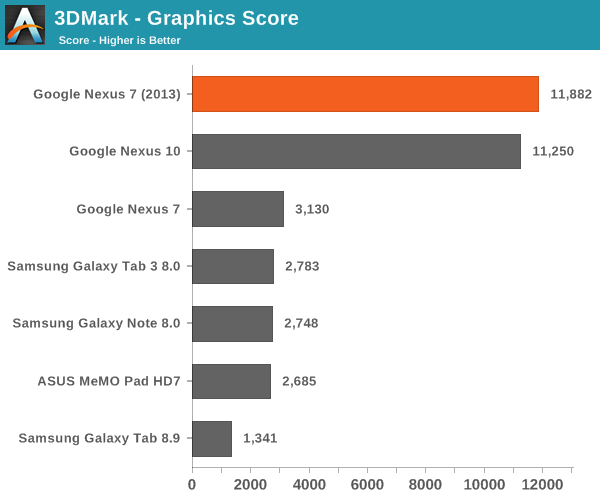
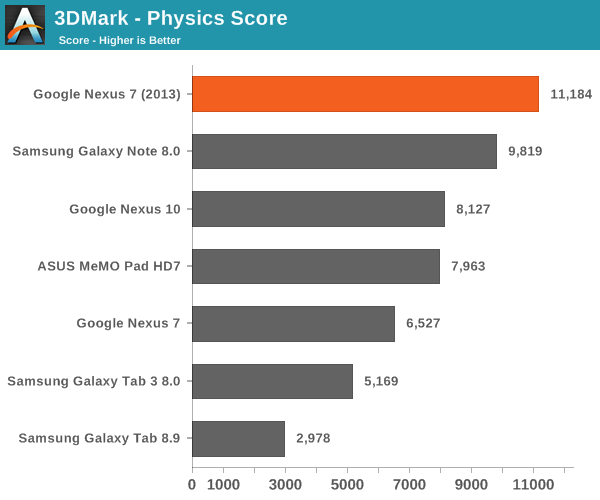
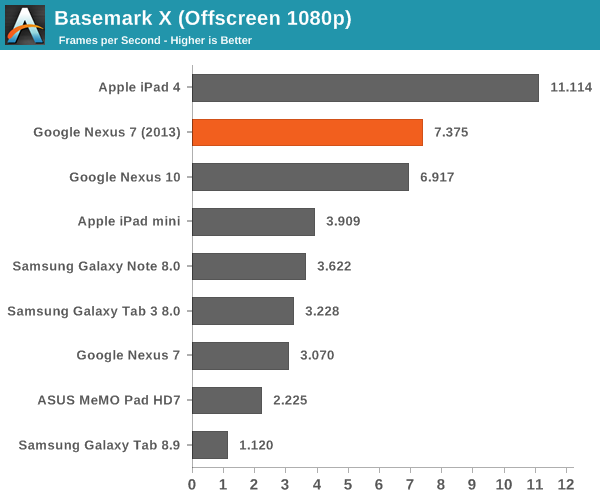
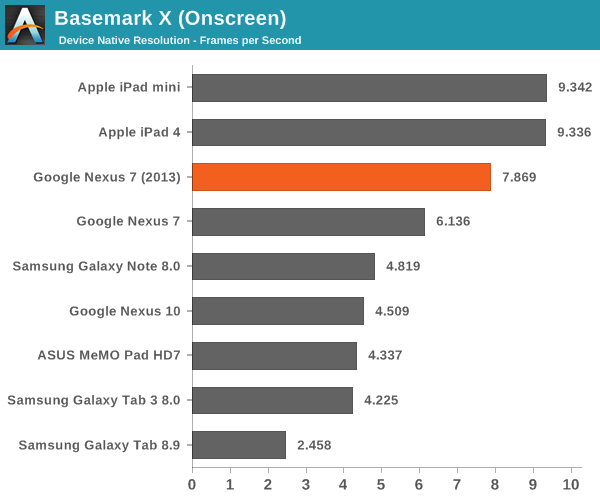
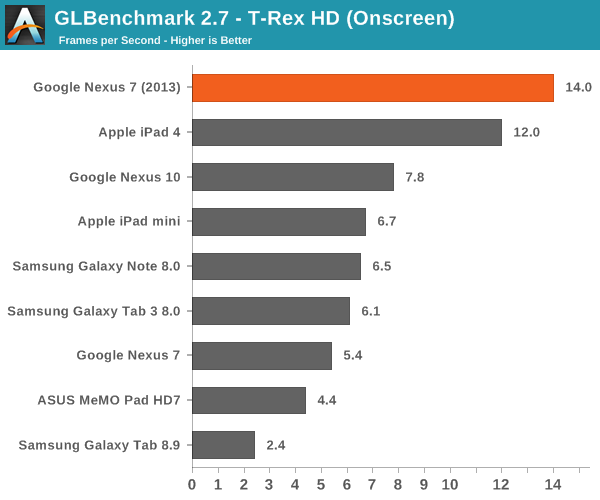
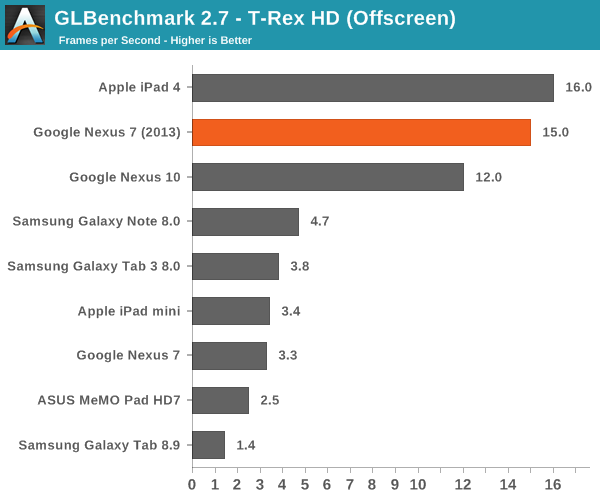
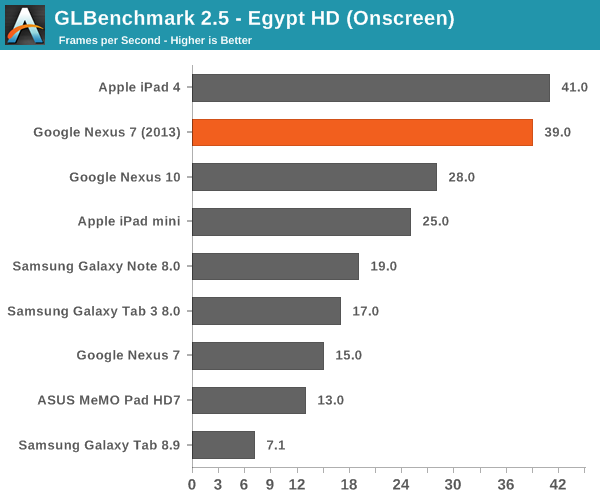
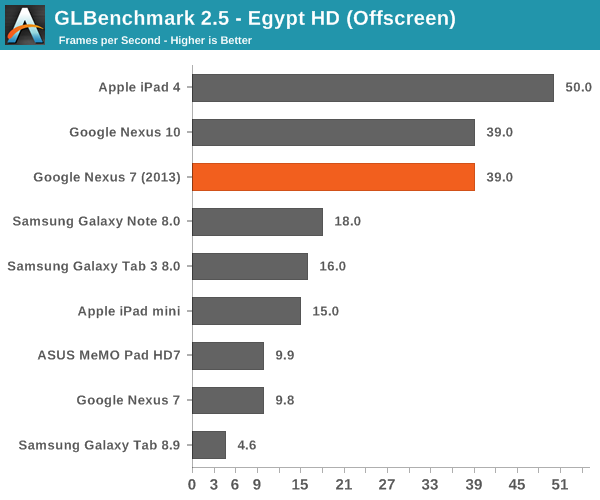
I played Modern Combat 4 as well as Shadowgun, both demanding 3D titles, on the new Nexus 7. Both titles appeared to render at the Nexus 7's native 1920 x 1200 resolution, and both appeared to do so at around 30 fps.


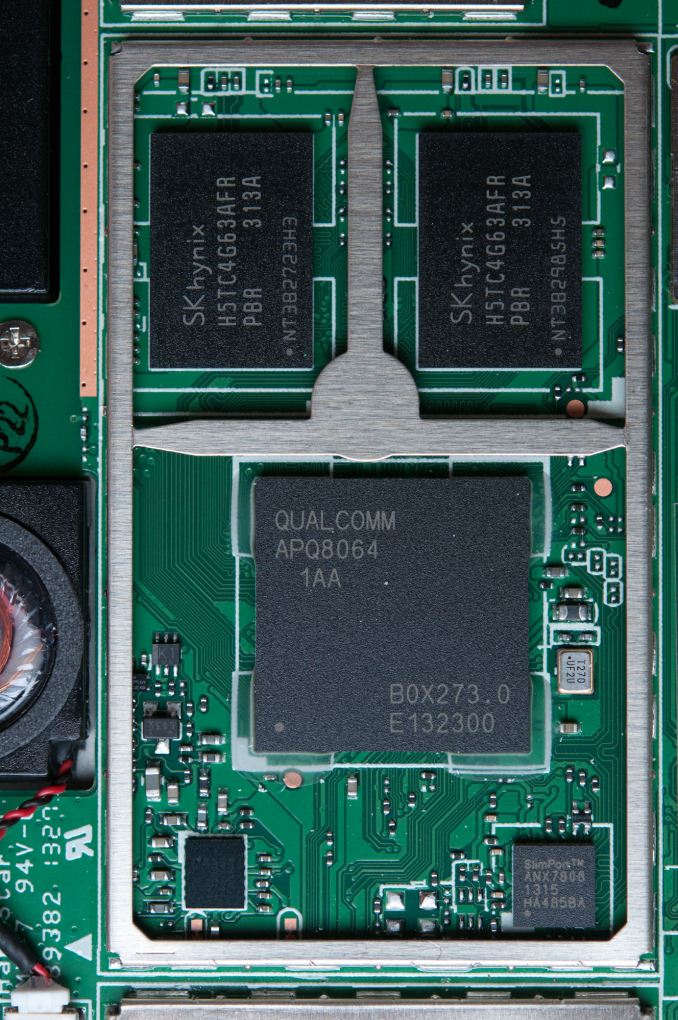
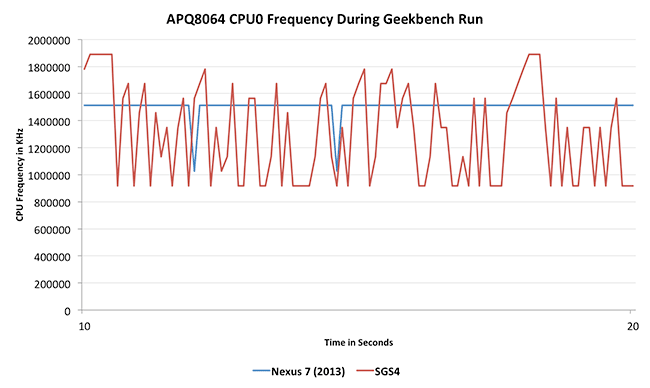
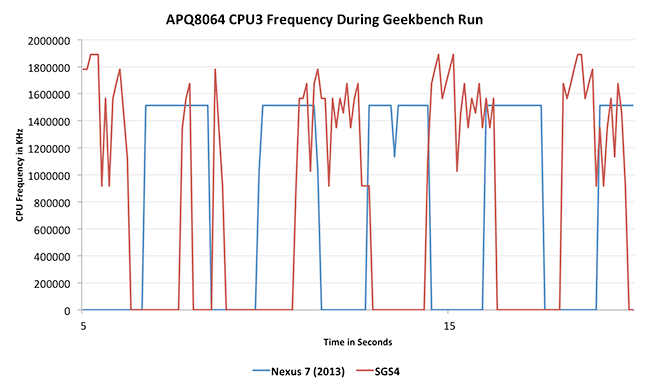








202 Comments
View All Comments
coldpower27 - Thursday, August 22, 2013 - link
Though bare in mind iPad mini is an old device due for a refresh in the Fall. A Retina display version, with a lower power A6X chip would do wonders. Unless you really love iOS, and the features Apple gives with their product, spec wise the Android tablet has them beat. But specs has never been all that is important when it came to these products. User experience is still key.looper - Thursday, August 22, 2013 - link
Coldpower27, I agree. Imagine the cost of a possible upcoming iPad Mini w/ Retina display.I wonder how much bigger one can make the default font size on the new Nexus7. My eyesight is not the best.
Oh, BTW, the word is "bear", not "bare"; and "specs *have* never been", not "has never been"... sorry.
mmarafie - Friday, August 23, 2013 - link
Yes of course :) When the new iPad mini is released that's when you'll see the Anand compare directly with the Nexus 7, and talk about how amazing the CPU/GPU in the mini are while again omitting mention of the price difference (probably double the cost of the N7) or any other strengths the N7 might have (higher ppi, more RAM, faster CPU etc).I'm still waiting for the review of the Nexus 10 which got released last year around the same time as iPad 4 (I own both), and the iPad 4 got the review in December while the Nexus 10 just got a preview.
weiran - Friday, August 23, 2013 - link
> any other strengths the N7 might have (higher ppi, more RAM, faster CPU etc).If a Retina iPad mini is released, it will have a higher PPI than this N7. And we all know that comparing specs in tablets is pointless if the comparison involves different OSes.
mmarafie - Friday, August 23, 2013 - link
Well define Retina please? If I'm not mistaken Apple considers 300 ppi and higher displays as Retina, yet the iPad 4 only has a 264 ppi display. The new Nexus 7 is over the 300 ppi magic number at 323. For the iPad mini to have a higher ppi than that it will need a higher resolution screen than the full HD one of the N7. It will need the same resolution as the iPad 4 (2048x1536) or higher. Its possible the new iPad mini will be released with a high res screen so we'll have to wait and see.kascollet - Saturday, August 24, 2013 - link
Retina is an Apple world, they can put it on whatever device they want but it always means :- pixels not visible at usual distance (more than 300 for a phone, more than 200 for a laptop, I between for a tablet...)
- high res is obtained by quadrupling the pixel count and thus conserving screen ratio and graphical elements size (makes all apps immediately compliant).
So if a Retina iPad Mini is made, it WILL feature a 2K x 1.5K resolution like the iPad 4.
retrospooty - Saturday, August 24, 2013 - link
"Retina is an Apple world, they can put it on whatever device they want but it always means :- pixels not visible at usual distance "
With a disclaimer - for 20/20 vision... Which is average eyesight, not above and not at all amongst the best. Most people with better eyesight may out around 400-450 DPI at 12 inches - some even higher.
Fri13 - Thursday, November 14, 2013 - link
20/20 is for normal eye sight, and it is the for most people.For most people (<90%) the 300 DPI at 20cm distance is more than enough, they can not see differences between that and 150 DPI without using magnification glass (lope actually) and compare exactly same content. With PPI there is no difference either unless you start looking trough very small details like in fonts from distance of 5-10cm and it isn't good for your eyes anyways. At normal viewing distance with tablet is 35-40cm.
When it comes to very good eye sight, last time what I read about the record (over decade ago) it was that a person could detect 6mm long string from distance of 2km, would be like display should have so high resolution that its density would be over 1.5 million on inch. But not even then a person with great eye sight could care less does display have a 150 PPI or 300 PPI.
I had once a friend and her eye sight was very good, she could read a normal news paper font (10-11 points) from distance of 20 meters. You couldn't not believe it without being there testing it. It was just jaw dropping that you could take any page and present it to her from 20m distance and she could read it a loud (we didn't test longer distance). But it was amazing how she could read a traffic signs text from few kilometer distance. It was like having a hawk what can talk to you.
The most important part in display pixel density is that font is rendered in manner it is clear to read. So you don't mistake letters and you don't need to spend much time quessing what letter is what.
Like how many is whining about 72-90 PPI in their workstation/laptop displays? They can read it perfectly fine, they don't find them disturbing to have much lower pixel density in their much bigger computer screen, but then they whine about smartphones and tablets if it is below 300 PPI.
retrospooty - Saturday, August 24, 2013 - link
"Well define Retina please?" - Retina is a marketing name Apple came up with for higher res screens. Apple fans, being a mostly non-technical bunch think it means something, but its arbitrary specs are just that... Arbitrary. 330+ isnt the end all be all of the DPI usefullness. The average eye cannot detect pixels at much higher DPI, but the other 1/2 of the world with above average eyesight can. IF you can see pixels, the higher hte better. If you cannot, save your $$$ and get something cheaper.abazigal - Saturday, August 24, 2013 - link
Retina is actually a combination of both PPI and distance of the screen from your eyes.Apple would probably explain that since users tend to hold the ipad further away from their eyes compared to a smartphone, the ipad4 can still be considered retina despite its lower PPI.
The ipad mini will likely have the same 2048x1536 display to maintain backwards compatibility with existing ipad apps. That gives it a PPI of 324 (same as iphone), putting it on par with the Nexus7.
My, hardware certainly has come a long way.